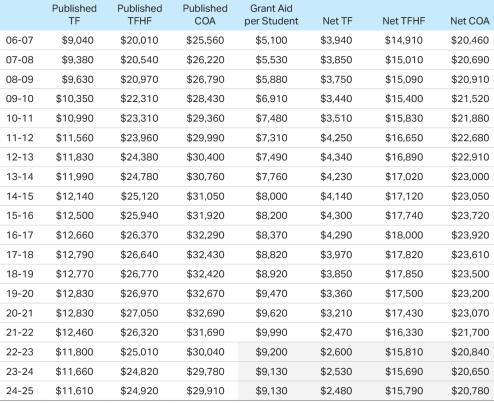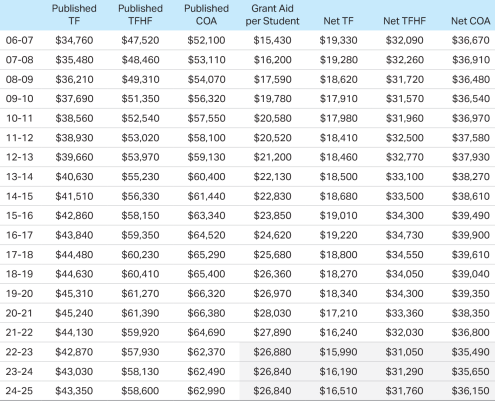Key Takeaways
- The total cost of college will include tuition, room and board, books, supplies, transportation, and other living expenses.
- Depending on the type of college you attend—a two-year college, four-year public in-state university, four-year public out-of-state university, or a four-year private university—you can expect to see different published tuition costs (the sticker price) and a different net cost of attendance (the total cost once factoring in financial aid).
- Public two-year colleges have the lowest average tuition ($4,050), while private four-year colleges have the highest ($43,350).
- Financial aid, like student loans and scholarships, can help significantly reduce the total cost of college.
From tuition, room and board, books, and supplies, you might be surprised about how much you’re really paying for your education. There can be a lot of guesswork when figuring out the true cost of college. Most often, we are only told the cost of tuition, plus room and board. But in reality, there are more costs to consider for college.
Understanding the true cost of college can give you a more realistic overall picture of the financials involved with attending college. And knowing this can help you make more informed decisions about which colleges are affordable for you—and which aren’t. Fortunately, we’ve taken the guesswork out of it for you and pored over the stats and charts related to college tuition to create a simple and easy-to-understand resource. This way, you can use real-life data to help you make an informed decision about your choice of college.
What Does the Total Cost of College Cover?
Colleges generally publish their cost of tuition for various programs on their website to give you an estimate of how much it will cost you to enroll in a particular program. However, this is only part of what you can expect to pay for a college education. Many families often overlook the miscellaneous expenses that are involved with attending college:
- Tuition and Fees
- Room and Board
- Textbooks and Supplies
- Transportation
Average Costs for Different College Types
According to the Education Data Initiative, the average cost to attend college is $38,270 per student. However, the cost of tuition will depend on the type of college you’re attending. In the U.S., higher education institutes may be a two-year college, a four-year public in-state university, a four-year public out-of-state university, or a four-year private university.
Below is the breakdown of each type of college’s 2024-25 average published prices for tuition. Seeing the different costs can help you get a better idea of how much you can expect to pay for a degree at each type of college:
| College Type | Tuition |
| Public Two-Year College | $4,050 |
| Public Four-Year In-State | $11,610 |
| Public Four-Year Out-of-State | $30,780 |
| Private Non-Profit Four-Year | $43,350 |
The tuition numbers you see are considered the “sticker costs” of colleges. These are similar to the sticker price on a car, meaning they don’t always reflect what you’ll actually pay. In addition to tuition, colleges have a cost of attendance (COA), which includes housing, food, books, supplies, transportation, and other expenses.
However, what you need to evaluate is the net price for a college—the actual cost after factoring in scholarships, grants, and other financial aid. This net price will give you a clearer picture of what you’ll actually be paying out of pocket.
Net Price vs Sticker Price for In-State Public Colleges
Let’s look at the 2024-2025 average published tuition and fees (sticker cost) and net cost of attendance (the total cost after factoring in financial aid) for in-state student tuition at a public four-year college:

Source: College Board Trends in Pricing 2024
You’ll see that the difference between the average published cost and the net cost for the 2024-2025 school year is quite drastic. The published cost of attendance is $29,910, while the net cost of attendance is only $20,780. That’s a difference of $9,130. You’ll need to borrow only what you need to cover the funding gap of the net cost, not the sticker cost.
Net Price vs Sticker Price for Private Non-Profit Colleges
Let’s look at the 2024-2025 average published tuition and fees (sticker cost) and net cost of attendance (the total cost after factoring in financial aid) for private non-profit institutions:

Source: College Board Trends in Pricing 2024
This table shows that there is a bigger cost difference between the published cost and net cost for private non-profit institutions. The full cost of attendance is listed at $62,990, but after scholarships and grants, the average net cost drops to $36,150. Yep, that’s a $26,840 yearly difference in tuition and fees that can save you almost six figures over your four years! Remember, you don’t need to borrow the full published cost—just enough to cover the net cost.
Understanding How Loans Factor Into the True Cost of College
Student loans are a major factor in your total college costs. If you are taking out loans, you must take the time to figure out how much the loans you take are actually going to cost you. This is where many students make the mistake of seeing their initial student loan balance and assuming that what they see is what they’re paying back. What they often fail to consider are the interest rates when looking at their loans.
To calculate the true cost of college with student loans, you need to factor in your projected loan amount, the interest rate on the loan, and your repayment plan. You can use this student loan calculator to calculate the actual amount you’ll be paying for college by the time you pay off your student loans.
Here are two options you can choose from to maximize your student loans:
- Federal Student Loans. These loans have much lower interest rates, which can save you thousands of dollars in accrued interest over the life of the loans. They also have more flexible repayment plans and other protections built into them. As of January 2025, the current federal interest rate for new undergraduate student loans is 6.53%.
- Private Student Loans. These loans are given by private lenders such as banks or credit unions. Some students choose to use private loans when federal loans don’t give enough or they are looking to get a loan faster. However, interest rates can vary significantly. As of January 2025, the average interest rate for private student loans ranges from 3.45% to 16.24%.
While most students will take on additional student loans to meet the total cost of attendance, this is not free money. Not only do you have to return all this money but you will also pay interest on whatever money you borrow by way of student loans. This is what one student had to say about taking student loans to cover miscellaneous costs:
“When I started college, I took out student loans for everything. I paid my rent, groceries, tuition, and other expenses with my loans so I could work minimal hours while in school. Using both private and federal loans throughout my time in college, I didn’t know how harsh my repayment plan was until a few months before I graduated. I was set to pay what felt like an astronomical amount each month with an entry-level salary. My payment was close to my rent so building my savings was difficult. If I could go back and tell myself to read more about student loans and other financial options, it would save me a lot of money down the road.”
–Hannah T. (University of Minnesota)
Don’t Forget About Scholarships!
When you’re calculating the true cost of college, you should also factor in scholarship money. Winning any scholarship money, however small the award, can help to lower your total college costs significantly. Scholarship money is free*, meaning you don’t have to pay that money back—and you don’t pay interest on it! You do have to put in the work to find opportunities that you qualify for and then put together a winning scholarship application—but trust us, it’s totally worth it. If you win, you could save thousands of dollars on your tuition and other college expenses.
The best part? There’s no limit to the number of scholarships you can apply for or the amount of money you can win. The more opportunities you apply for, the higher your chances of winning and lowering your net cost of college. Use this FREE scholarship finder tool to look for scholarships you qualify for.
How Much Will MY College Really Cost?
Good news! College Raptor helps make it easier for you to understand what you will actually pay. We start by pulling the sticker price from Iped’s College Navigator, then estimate your net price for each of the colleges you are looking at by estimating grants, scholarships, and other forms of aid you may qualify for.
Here’s how to get started:
- Sign up for a College Raptor account.
- Follow the prompts to enter your academic and major preferences, resident information, test scores and grades, and family financial information.
- Add colleges that you are interested in to your favorites list.
- Compare colleges and see your estimated net prices on your college match dashboard!
In just a few minutes, you’ll be able to see the estimated price of attendance, estimated grant aid, and estimated net price of your education per year at specific colleges. This tool can help you decide which college is a better fit for you financially so you can make your attendance decision with confidence.
Pro Tip: While all the form fields are NOT required, the more information you input, the more accurate your net price estimate will be.
The Benefits of Having a College Degree
There are plenty of benefits and perks that make earning a college degree worth it. Just think, even if you start at an entry-level position after graduation, you’ll have the foundation you need to qualify for a raise faster. Not to mention, college graduates generally earn more than those who completed high school. This means you could make up for the cost of college in just a few years.
Another benefit of earning a college degree is that it qualifies you to sit for advanced exams and earn certifications that will help to fast-track your career. These certifications open doors for more challenging roles with higher salaries and attractive perks.
Is College Worth the Cost?
Even with knowing the true cost of college, we still like to think that the answer is yes: college is worth the cost. The degree you earn when you graduate from college holds a lot of value when you’re looking for a job. It tells prospective employers that you have the knowledge and skills needed for the job, making you a more suitable candidate. Our advice? Don’t let the real cost of college deter you from starting your college journey. The key is to make informed decisions that will help you graduate with fewer financial surprises and hopefully lower debt.
Wondering which college is the best fit for you? Use our FREE College Match tool to find schools that align with your test scores, GPA, location and culture preferences, and more!
*While a scholarship does not have to be repaid, there may be other obligations associated with the scholarship.





